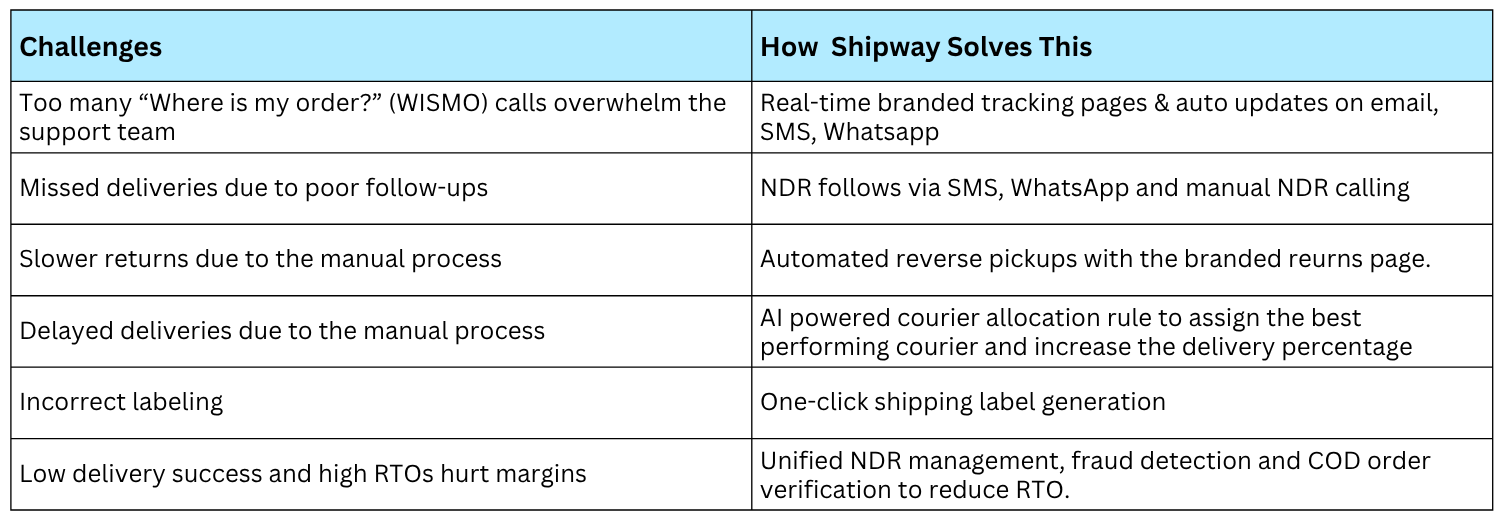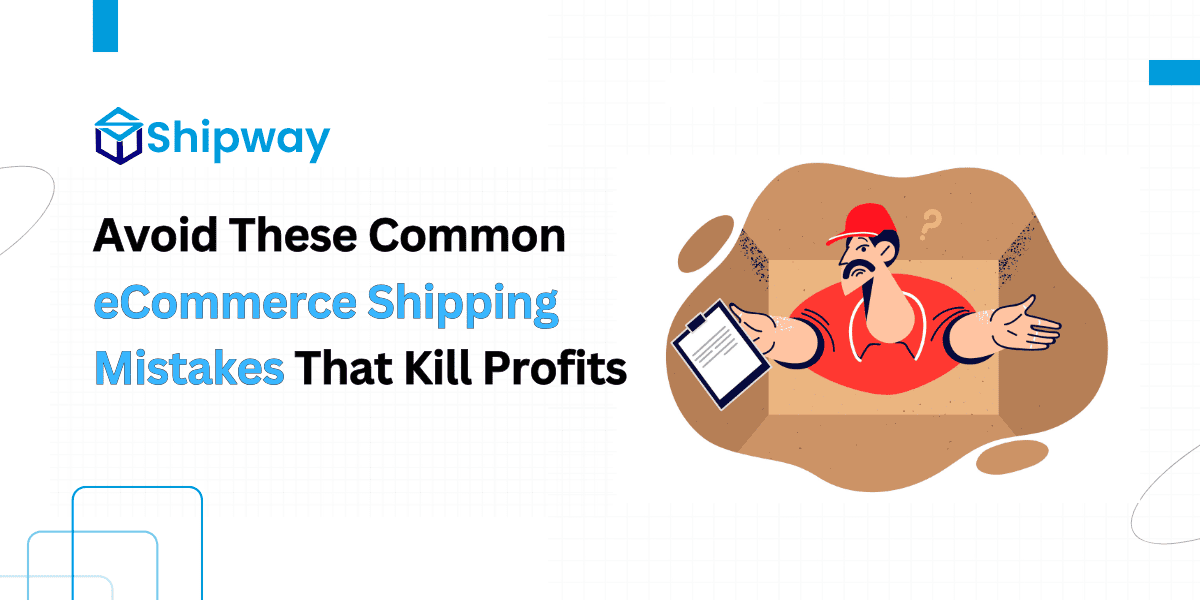In eCommerce, logistics isn’t just a backend function; it’s the lifeline of customer experience and profitability. Even a small shipping error, like a wrong pin code, a delayed dispatch, or a missed delivery attempt, can set off a chain reaction of cancellations and customer dissatisfaction, and high shipping costs.
Unfortunately, these slip-ups are part of many sellers’ daily reality. In fact, India’s logistics inefficiencies cost the economy a staggering $65 billion every year, as per industry estimates. For D2C brands and online sellers, a significant portion of these losses stems from everyday mistakes that often go unnoticed until profits begin to bleed.
That’s why we put this guide together. We break down 10 common shipping mistakes that silently erode your margins and damage your brand reputation, along with practical fixes to stop the leak before it hurts your bottom line.
10 Common Shipping Mistakes eCommerce Sellers Overlook
1. Not Considering All Shipping Expenses
Shipping charges can be more complex than they appear at first glance. Beyond the base rate, several variables, like volumetric weight, delivery zones, COD handling, peak-season surcharges, return costs, and fuel levies, can significantly impact the final bill.
Many businesses overlook these hidden fees, leading to underpriced products or eroded margins. It’s always better to conduct thorough research and factor in all cost components before finalizing shipping strategies. Taking a holistic view ensures that logistics remains a driver of growth, not a silent profit killer.
Impact On Profitability
- Increased logistics expenses from unaccounted fees
- Inaccurate profit margins and forecasting
- Higher RTO losses impact the bottom line
2. Not Checking Pincode Serviceability
Different courier partners have different strengths; some cover metro cities better, while they may not be active in remote or regional areas. That’s why checking PIN code serviceability before confirming an order is important. It ensures the chosen courier can successfully deliver to the customer’s location, prevents last-minute handovers to third parties, and reduces the risk of delivery delays or failures. A quick serviceability check can go a long way in improving delivery success and customer satisfaction.
Impact on Profitability
- Shipping cost loss due to automatic RTO after failed delivery
- Wasted manpower and packaging resources on undeliverable orders
- Increased cost per shipment from last-minute courier reallocation
3. Inaccurate Weight Calculation
Many sellers calculate the weight inaccurately, especially the new sellers who could be unaware that most companies charge on the basis of volumetric weight, not the actual weight. Here is how it is calculated:
Volumetric Weight Formula: Length (cm) x Width (cm) x Height (cm) / 5000
Shipping charges are applied based on whichever weight is greater, actual or volumetric. For instance, a bulk item like a 3 kg pillow can have a volumetric weight of 7 kg, so the charge will be according to volumetric weight. Accurate weight information is essential to avoid extra shipping costs.
Impact on Profitability
- Overbilling due to higher volumetric weight charges
- Disputes and penalties from courier partners
- Increased cost per order from repeated miscalculations
4. Avoiding Shipping Insurance
Shipping insurance acts as a safety net for your business. It provides financial protection in case a package is lost, stolen, or damaged during transit. This is especially important for high-value items like electronics, luxury fashion, or bulk orders. Without insurance, any loss is yours to bear, and over time, even a few such incidents can add up to serious profit leakage. With insurance in place, you’re not only protecting your margins but also ensuring that unexpected mishaps don’t hurt your bottom line or customer trust.
Quick read – How to Safely Ship High-Value Items with Insurance for Your eCommerce Store?
Impact on Profitability
- Direct financial loss from lost or damaged shipments
- No reimbursement for high-value order losses
- Increased cost burden on the business for order replacements
5. Lack of Picking and Packing Discipline
Running an e-commerce brand means keeping a lot of small but important things in check. One of them is picking and packing discipline. If your team isn’t careful, orders get delayed, wrong products are shipped, or the wrong box size is used. These small mistakes lead to returns, higher shipping costs, and wasted time. And all of this quietly eats into your margins. It may not seem like a big deal at first, but over time, it becomes a serious problem for your profitability.
Impact on Profitability
- Increased return rates due to wrong or damaged items
- Higher shipping costs from incorrect packaging sizes
- Wasted labor hours on error correction and reprocessing
Labels and paperwork might seem like a small part of the shipping process, but getting them wrong can cause big headaches. If the label is missing, incorrect, or loosely attached, the package might never reach your customer. Worse, if important documents like invoices or GST papers are incomplete or missing, the shipment could get stuck at checkpoints or returned altogether.
Mistakes also happen when the wrong item count is entered, the recipient details are inaccurate, or the terms on a Bill of Lading are overlooked. These slip-ups can lead to delays, fines, or even claim rejections. Proper labeling and accurate documentation aren’t optional; they’re what keep your shipments moving smoothly and your profits protected.
Impact on Profitability
- Order delays or returns due to misrouted shipments
- Penalties or shipment holds due to missing compliance documents
- Extra costs from manual intervention and reprocessing
6. Not Notifying Customers About Delays
When you don’t inform customers about a delay, it creates confusion and breaks their trust. They start wondering where their order is, and that often leads to frustration or even cancellations. It’s always better to send a quick update and keep them informed. A simple message goes a long way in maintaining trust and showing that you value their time.
Impact on Profitability
- Increased order cancellations due to uncertainty
- Higher support load from customer complaints and inquiries
- Loss of future revenue from dissatisfied customers
7. Not Providing Tracking Facility
Customers want to know where their order is once it’s shipped. If they don’t receive tracking details, they’re more likely to get frustrated, raise complaints, or even cancel the order.
Not sharing real-time tracking creates confusion and leads to more support tickets. It’s much better to set up automatic updates through SMS, WhatsApp, or email. Even a simple tracking link can make a big difference. When customers can track their order easily, it builds trust and gives them peace of mind.
Impact on Profitability
- Higher support costs due to increased WISMO (“Where is my order?”) queries
- Order cancellations from anxious or uninformed customers
- Lower repeat purchases due to poor post-purchase experience
8. Not Planning for Returns
Selling across marketplaces like Myntra, Meesho, and Flipkart, especially in fashion and cosmetics, comes with a common pain point: high return volumes. From size issues to personal preferences, returns are part of the game. In fact, up to 30% of online orders are returned, regardless of how perfect the product or delivery was. This often happens because customers tend to order multiple options, try them at home, and return the ones they don’t like, a common behavior in today’s online shopping experience.
If your reverse logistics isn’t streamlined or automated, it can quickly spiral into operational chaos. Delayed return pickups frustrate customers and lead to poor reviews, while misplaced or untracked items result in inventory mismatches and lost revenue. Manual handling also slows down refund processing, triggering a surge in customer support tickets.
Impact on Profitability
- Higher RTO and Refund Losses
- Blocked Inventory & Lost Sales
- Increased Operational Costs (manual effort, extra pickups, repackaging)
9. Relying on One Courier Partner
Running an e-commerce business while depending on a single courier partner is rarely practical. No single delivery partner can cover every pin code, handle all product types, or meet varying service-level expectations. Some may not serve remote areas, while others may fall short on handling specific shipment sizes or categories. Moreover, relying on one courier limits your ability to negotiate or compare rates, often resulting in higher shipping costs.
On the other hand, working with multiple courier partners allows brands to optimize costs by selecting the most cost-effective courier option per order, based on destination, product type, and delivery speed, ultimately improving profitability and service reach.
Impact On Profitability
- Uncompetitive Rates, Higher Costs, Lower Margins
- May not support same-day delivery and hyperlocal delivery due to higher order volume.
10. Not Verifying Customer Addresses or COD Orders
Skipping verification of customer addresses or COD orders can lead to failed deliveries, increased RTOs, and revenue loss. COD verification is crucial as it confirms that the person receiving the package is the same as the one who placed the order.
It also ensures payment is collected upon delivery, reducing the risk of non-payment or fake orders. Address validation further helps avoid delivery delays and improves first-attempt success rates, both of which are essential for maintaining profitability and customer trust.
Impact On Profitability
- Higher RTO Costs
- Lost Inventory & Revenue
How to Avoid These Ecommerce Logistics Errors
Here are some practical ways to prevent common shipping and logistics mistakes.
1. Calculate True Shipping Costs
Include volumetric weight, COD charges, returns, and surcharges to avoid margin leaks. Figure out the smart but correct ways to reduce your shipping costs.
2. Check Pincode Serviceability
Use courier APIs to ensure service coverage before order confirmation. This way, you can streamline your multichannel operations.
3. Weigh & Measure Accurately
Use proper tools to avoid billing surprises and weight discrepancies resulting from volumetric mismatches.
4. Opt for Shipping Insurance
Protect high-value shipments from loss, damage, or theft.
5. Streamline Pick & Pack
Standardize workflows to avoid errors, delays, and returns.
6. Automate Labeling & Docs
Auto-generate shipping labels and invoices to reduce manual mistakes.
7. Notify Delays Proactively
Send alerts via WhatsApp/SMS to keep customers informed.
8. Enable Real-Time Tracking
Give buyers a live tracking link to reduce “Where’s my order?” queries.
How Shipping Aggregators Help Reduce Errors
1. Centralized Shipping Operations
Courier aggregators like Shipway let you manage all your shipping in one place, so you don’t have to work with different courier partners one by one. This makes things faster, easier, and more organized. Plus, it helps you get better rates and improve how you handle deliveries overall.
Benefits
- All your shipping reports in one place to help you make smarter decisions
- Process multiple orders together to save time and lower shipping costs
- Get better courier rates by shipping higher volumes through one platform
2. Choose the Best Courier for Every Order
With a courier aggregator, you don’t have to rely on just one delivery partner. You can easily compare shipping rates from different couriers in real-time and pick the most affordable or fastest courier service for each order, helping you save money and improve delivery performance.
Benefits
- Pick the lowest-cost courier or best-performing courier for each delivery location
- Avoid paying extra for services you don’t actually need
- Balance speed and cost to make your shipping more efficient
- Save more on each shipment
3. Unlock Lower Shipping Costs Through Partnerships
Courier aggregator platforms work with several delivery partners and ship at high volumes. This allows them to secure better rates, which are then passed on to you. As a result, even smaller businesses can benefit from bulk pricing they wouldn’t get on their own.
Benefits
- Affordable rates for shipping within India and abroad
- Lower prices when you ship in bulk
- Cost savings that directly improve your profit margins
Simplify Your Ecommerce Logistics With Shipway
Shipway is an e-commerce logistics solution that brings all your shipping needs under one roof. As a powerful logistics aggregator, it simplifies order tracking, returns, courier selection, and NDR management across all sales channels, so you can stop juggling tools and start focusing on what matters most, i.e., growing your business.
Here’s a quick look at some common operational challenges eCommerce brands face, and how Shipway helps solve them efficiently:

Get Shipping Right with a Few Smart Fixes
In e-commerce, even small shipping mistakes, such as a wrong PIN code, missed delivery, or lack of tracking, can turn into big problems. They lead to frustrated customers, extra costs, and lost sales. To keep your profits safe and your customers happy, you need to avoid these common ecommerce shipping mistakes. From choosing the right courier service to setting up proper courier tracking and returns, every step counts. If you’re looking to improve your ecommerce delivery, lower RTOs, and give your customers a smooth post-purchase experience, it’s time to rethink your logistics strategy.




